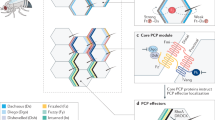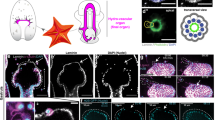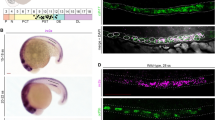Abstract
Cystic kidney diseases are a global public health burden, affecting over 12 million people1. Although much is known about the genetics of kidney development and disease, the cellular mechanisms driving normal kidney tubule elongation remain unclear2,3. Here, we used in vivo imaging to show for the first time that mediolaterally oriented cell intercalation is fundamental to vertebrate kidney morphogenesis. Unexpectedly, we found that kidney tubule elongation is driven in large part by a myosin-dependent, multicellular rosette–based mechanism, previously only described in Drosophila melanogaster. In contrast to findings in Drosophila, however, non-canonical Wnt and planar cell polarity (PCP) signaling is required to control rosette topology and orientation during vertebrate kidney tubule elongation. These data resolve long-standing questions concerning the role of PCP signaling in the developing kidney and, moreover, establish rosette-based intercalation as a deeply conserved cellular engine for epithelial morphogenesis.
This is a preview of subscription content, access via your institution
Access options
Subscribe to this journal
Receive 12 print issues and online access
$209.00 per year
only $17.42 per issue
Buy this article
- Purchase on Springer Link
- Instant access to full article PDF
Prices may be subject to local taxes which are calculated during checkout





Similar content being viewed by others
References
Torres, V.E., Harris, P.C. & Pirson, Y. Autosomal dominant polycystic kidney disease. Lancet 369, 1287–1301 (2007).
McNeill, H. Planar cell polarity and the kidney. J. Am. Soc. Nephrol. 20, 2104–2111 (2009).
Chapin, H.C. & Caplan, M.J. The cell biology of polycystic kidney disease. J. Cell Biol. 191, 701–710 (2010).
Costantini, F. Renal branching morphogenesis: concepts, questions, and recent advances. Differentiation 74, 402–421 (2006).
Karner, C.M. et al. Wnt9b signaling regulates planar cell polarity and kidney tubule morphogenesis. Nat. Genet. 41, 793–799 (2009).
Nishio, S. et al. Loss of oriented cell division does not initiate cyst formation. J. Am. Soc. Nephrol. 21, 295–302 (2010).
Fischer, E. et al. Defective planar cell polarity in polycystic kidney disease. Nat. Genet. 38, 21–23 (2006).
Saburi, S. et al. Loss of Fat4 disrupts PCP signaling and oriented cell division and leads to cystic kidney disease. Nat. Genet. 40, 1010–1015 (2008).
Goodrich, L.V. & Strutt, D. Principles of planar polarity in animal development. Development 138, 1877–1892 (2011).
Nishimura, T. & Takeichi, M. Shroom3-mediated recruitment of Rho kinases to the apical cell junctions regulates epithelial and neuroepithelial planar remodeling. Development 135, 1493–1502 (2008).
Wagstaff, L.J., Bellett, G., Mogensen, M.M. & Munsterberg, A. Multicellular rosette formation during cell ingression in the avian primitive streak. Dev. Dyn. 237, 91–96 (2008).
Blankenship, J.T., Backovic, S.T., Sanny, J.S., Weitz, O. & Zallen, J.A. Multicellular rosette formation links planar cell polarity to tissue morphogenesis. Dev. Cell 11, 459–470 (2006).
Jones, E.A. Xenopus: a prince among models for pronephric kidney development. J. Am. Soc. Nephrol. 16, 313–321 (2005).
Raciti, D. et al. Organization of the pronephric kidney revealed by large-scale gene expression mapping. Genome Biol. 9, R84 (2008).
Wallingford, J.B. et al. Dishevelled controls cell polarity during Xenopus gastrulation. Nature 405, 81–85 (2000).
Kieserman, E.K., Glotzer, M. & Wallingford, J.B. Developmental regulation of central spindle assembly and cytokinesis during vertebrate embryogenesis. Curr. Biol. 18, 116–123 (2008).
Kim, S.K. et al. Planar cell polarity acts through septins to control collective cell movement and ciliogenesis. Science 329, 1337–1340 (2010).
Bertet, C., Sulak, L. & Lecuit, T. Myosin-dependent junction remodelling controls planar cell intercalation and axis elongation. Nature 429, 667–671 (2004).
Rauzi, M., Lenne, P.F. & Lecuit, T. Planar polarized actomyosin contractile flows control epithelial junction remodelling. Nature 468, 1110–1114 (2010).
Tamada, M., Farrell, D.L. & Zallen, J.A. Abl regulates planar polarized junctional dynamics through β-catenin tyrosine phosphorylation. Dev. Cell 22, 309–319 (2012).
Straight, A.F. et al. Dissecting temporal and spatial control of cytokinesis with a myosin II inhibitor. Science 299, 1743–1747 (2003).
Lienkamp, S. et al. Inversin relays Frizzled-8 signals to promote proximal pronephros development. Proc. Natl. Acad. Sci. USA 107, 20388–20393 (2010).
Zallen, J.A. & Wieschaus, E. Patterned gene expression directs bipolar planar polarity in Drosophila. Dev. Cell 6, 343–355 (2004).
Winter, C.G. et al. Drosophila Rho-associated kinase (Drok) links Frizzled-mediated planar cell polarity signaling to the actin cytoskeleton. Cell 105, 81–91 (2001).
Lee, J.Y. et al. Wnt/Frizzled signaling controls C. elegans gastrulation by activating actomyosin contractility. Curr. Biol. 16, 1986–1997 (2006).
Rabut, G. & Ellenberg, J. Automatic real-time three-dimensional cell tracking by fluorescence microscopy. J. Microsc. 216, 131–137 (2004).
Kolega, J. Phototoxicity and photoinactivation of blebbistatin in UV and visible light. Biochem. Biophys. Res. Commun. 320, 1020–1025 (2004).
Avants, B.B., Epstein, C.L., Grossman, M. & Gee, J.C. Symmetric diffeomorphic image registration with cross-correlation: evaluating automated labeling of elderly and neurodegenerative brain. Med. Image Anal. 12, 26–41 (2008).
Brox, T., Bruhn, A., Papenberg, N. & Weickert, J. High accuracy optical flow estimation based on a theory for warping. European Conference on Computer Vision (ECCV) Vol. 3024 of. LNCS 25–36 (2004).
Otsu, N. A threshold selection method from gray-level histograms. IEEE Trans. Sys. Man Cyber. 9, 62–66 (1979).
Acknowledgements
We would like to thank A. Ewald for critical comments on the manuscript; A. Ley for excellent technical assistance, the Life Imaging Center (LIC) at the Centre of Systems Biology at Freiburg University for technical support with confocal microscopy and, in particular, S. Jin form the LIC for programming the tracking macro used in the acquisition of some time-lapse analysis; M. Keuper for digital image analysis; and E.J. Bellefroid (Bruxelles, Belgium) for providing the pCS2+MT-GR plasmid. S.S.L. is supported by the Deutsche Forschungsgemeinschaft (DFG) as part of the Klinische Forschergruppe (KFO) 201. T.J.C. is supported by grants from the March of Dimes, the US National Institutes of Health (NIH; 1R01DK080004) and the UT Southwestern O'Brien Kidney Research Foundation (NIH P30DK079328). O.R., K.L. and G.W. are supported by the Excellence Initiative of the German Federal and State Governments (EXC 294-BIOSS). J.B.W. is supported by the NIH/National Institute of General Medical Sciences (NIGMS), the March of Dimes, the Burroughs Wellcome Fund and the UT Southwestern O'Brien Kidney Research Center (NIH P30DK079328). J.B.W. is an Early Career Scientist of the Howard Hughes Medical Institute. G.W. is supported by the DFG KFO 201 and by the European Community's Seventh Framework Programme (grant agreement 241955, SYSCILIA).
Author information
Authors and Affiliations
Contributions
S.S.L., C.M.K., T.J.C., J.B.W. and G.W. designed the experiments, S.S.L., K.L., C.M.K. and O.R. performed experiments. S.S.L., K.L., C.M.K., T.J.C., O.R., J.B.W. and G.W. analyzed the data and wrote the manuscript.
Corresponding authors
Ethics declarations
Competing interests
The authors declare no competing financial interests.
Supplementary information
Supplementary Text and Figures
Supplementary Figures 1–14 and Supplementary Note (PDF 2099 kb)
Supplementary Movie 1
Changes in tubule length and diameter during development. Confocal stacks of staged embryos were acquired after staining for β-Catenin (cell membranes, red), Tomato-Lectin (tubule epithelial membranes, green) and DAPI (nuclei, blue). The epidermis was optically removed. (MOV 4341 kb)
Supplementary Movie 2
Tissue rearrangement during pronephros formation. Confocal time-lapse recordings were performed at low magnification (10 x objective) in 12-minute intervals. Cells were labeled by membrane GFP (green) and nuclear (Histone-)RFP (red) in the pronephros of Xenopus embryos. (MOV 4153 kb)
Supplementary Movie 3
Convergent extension during tubule formation. Xenopus tubule cells were labeled by membrane-associated GFP (gray); time lapse-recordings were performed at higher magnification (25 x objective) in 5-minute intervals. A layer of highest contrast was extracted (see Suppl Note). (MOV 4160 kb)
Supplementary Movie 4
Convergent extension during tubule formation – 2. A filtered image of Suppl Movie 3 was used for cell tracking and segmentation. A subset of cells that is visible throughout the movie was randomly colored to visualize cell rearrangement during tubule extension. (MOV 2924 kb)
Supplementary Movie 5
Rosette formation during tubule elongation. Cell tracking and rosette detection was performed on Suppl Movie 3. Tracked cells are labeled by colored diamonds and rosettes formed by at least 5 cells were circled in yellow. (MOV 8193 kb)
Supplementary Movie 6
Blebbistatin inhibits directed cell movements. Cells were labeled by membrane-associated RFP (gray). Simultaneous time-lapse recordings were performed of DMSO- and blebbistatin-treated Xenopus embryos of the same batch. Cells were tracked by yellow spots. (MOV 2442 kb)
Supplementary Movie 7
formation is reduced in blebbistatin treated embryos. Filtered images of Suppl. Movie 5 superimposed with the result of semi-automated rosette detection (see Supplementary Material and Methods). Rosettes that result from the same cells in multiple frames received the same color and were counted once. (MOV 5459 kb)
Supplementary Movie 8
Xdd1 expression disorients cell movement. The Xdd1-GR expression was activated by dexamethasone treatment in Xenopus embryos. After time lapse recording, cells were tracked by randomly colored spots. (MOV 3789 kb)
Rights and permissions
About this article
Cite this article
Lienkamp, S., Liu, K., Karner, C. et al. Vertebrate kidney tubules elongate using a planar cell polarity–dependent, rosette-based mechanism of convergent extension. Nat Genet 44, 1382–1387 (2012). https://doi.org/10.1038/ng.2452
Received:
Accepted:
Published:
Issue Date:
DOI: https://doi.org/10.1038/ng.2452
This article is cited by
-
Planar cell polarity pathway in kidney development, function and disease
Nature Reviews Nephrology (2021)
-
β-Catenin and FGFR2 regulate postnatal rosette-based adrenocortical morphogenesis
Nature Communications (2020)
-
Cytokinetic bridge triggers de novo lumen formation in vivo
Nature Communications (2020)
-
A morphogenetic EphB/EphrinB code controls hepatopancreatic duct formation
Nature Communications (2019)
-
From morphogen to morphogenesis and back
Nature (2017)



